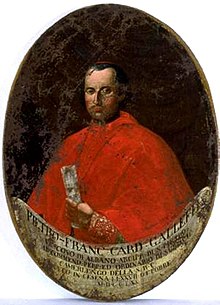Pietro Francesco Galleffi
Pietro Francesco Galleffi , also Pier Francesco Galleffi (born October 27, 1770 in Cesena , † June 18, 1837 in Rome ) was an Italian cardinal of the Roman Church .
Life
Early years
Galleffi, son of a patrician family from Cesena, was taught in the Franciscan convent of Cesena from 1780 and in Rome from 1791. In 1794 he became canon of the Vatican Basilica, in 1798 he was forced to leave the city by the rulers of the Roman Republic . In 1800 Pope Pius VII awarded him the titles of Papal House Prelate and Apostolic Protonotary. Around this time he was ordained a priest .
Elevation to cardinal and French captivity
In the consistory of July 11, 1803, Pius VII accepted him as cardinal priest of San Bartolomeo all'Isola in the college of cardinals . Two months later he appointed him abbot commander of San Benedetto e Scolastica in Subiaco . In 1805 he became cardinal protector of the Order of Canon Regulars . Because of his resistance to Napoleon Bonaparte , Cardinal Galleffi was again expelled from Rome in 1808. Since he refused to attend the emperor's second wedding with Marie-Louise of Austria in the following year, the latter forbade him and other cardinals to wear his official attire (“black cardinal”) and held him for several years.
After French rule
Cardinal Galleffi was only released in 1814, after the end of French rule, and was able to further increase his influence. He became chamberlain of the college of cardinals (until 1818) and cardinal protector of the Augustinian order in 1815 . In 1817 he became the private tutor of Pio Braschi, the great-nephew of Pope Pius VI. In 1817 Pius VII appointed him prefect of the Congregation for Religious Discipline .
In 1819 Galleffi was appointed titular archbishop of Damascus . He received the episcopal ordination on September 12, 1819 from Cardinal Dean Alessandro Mattei . Co- consecrators were Geraldo Maciotti and Francesco Albertini . In 1820 he became archpriest of the Vatican Basilica. In the same year he became Cardinal Bishop of Albano . After the death of Pius VII, he took part in the conclave in 1823 and led the conservative wing. Pope Leo XII. appointed him Camerlengo in December 1824 . As such, he led after the death of Leo XII. the official business in the Vatican. Due to his conservative and rigorous attitude in religious matters, he became one of the most important advisers to Leo XII. and was actively involved in reversing the administrative reforms of former Cardinal Secretary of State Ercole Consalvi .
Late years and death
Cardinal Galleffi took part in the conclave of 1829 and in 1830 became cardinal subdean and cardinal bishop of Porto e Santa Rufina . In the conclave, however, he supported the also very conservative Emmanuele De Gregorio . Whose defeat ushered in the end of Galleffi's political career. The suburbicarian diocese of Porto e Santa Rufina, for example, was of less importance than Albano. After the early death of Pius VIII , he took part in the conclave 1830–1831 , in which Gregory XVI. was elected, and led as Camerlengo again the official business during the Sedisvakanz . Six years later he died at the age of 66 and was buried in the Roman church of Santissima Trinità dei Pellegrini in the family grave of the Galleffi.
literature
- Paolo Alvazzi del Frate: GALLEFFI, Pietro Francesco. In: Fiorella Bartoccini (ed.): Dizionario Biografico degli Italiani (DBI). Volume 51: Gabbiani-Gamba. Istituto della Enciclopedia Italiana, Rome 1998.
Web links
- Galleffi, Pietro Francesco. In: Salvador Miranda : The Cardinals of the Holy Roman Church. ( Florida International University website), accessed December 5, 2013.
- Entry on Pietro Francesco Galleffi on catholic-hierarchy.org
| predecessor | Office | successor |
|---|---|---|
| Bartolomeo Pacca |
Cardinal Bishop of Porto e Santa Rufina 1830–1837 |
Emmanuele De Gregorio |
| Michele Di Pietro |
Cardinal Bishop of Albano 1820–1830 |
Giovanni Francesco Falzacappa |
| Bartolomeo Pacca |
Cardinal Sub- Dean 1830–1837 |
Emmanuele De Gregorio |
| Bartolomeo Pacca |
Camerlengo 1824-1837 |
Giacomo Giustiniani |
| personal data | |
|---|---|
| SURNAME | Galleffi, Pietro Francesco |
| ALTERNATIVE NAMES | Galleffi, Pier Francesco |
| BRIEF DESCRIPTION | Italian clergyman, cardinal of the Roman Church |
| DATE OF BIRTH | October 27, 1770 |
| PLACE OF BIRTH | Cesena |
| DATE OF DEATH | June 18, 1837 |
| Place of death | Rome |
